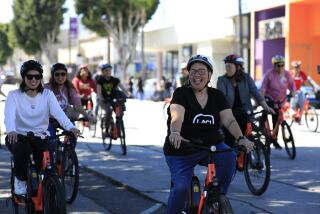When it comes to bike paths, L.A. should look to Orange County
They have bicycles in Orange County too, you know. And, as it turns out, an aggressive and interesting program to expand the bike path system. Which makes me happy, since I live in Orange County — and even though I’m not a cyclist. It’s part of a pact I have with gravity: We don’t mess with each other.
But much like dieting, I admire in others the impetus to ride, and it’s good to see that the Orange County Transportation Authority has assumed a strong role in crafting a cycling planning overlay spanning the county’s 34 cities. At the same time, the agency helps officials at the municipal level tailor their projects to fit within the broader scheme. In fact, according to Eric Bruins, planning and policy director for the Los Angeles County Bicycle Coalition, Orange County is far ahead of Los Angeles County when it comes to regionalizing its vision of bike paths.
Orange County began planning in the 1990s, when cities ran into problems trying to figure out where to lay out their bike paths. They were fine within their borders. But a path ending at, say, the Fullerton-La Habra city line doesn’t do much good if the next one hits the border at a different spot. So the transportation agency adopted its Commuter Bikeways Strategic Plan in 1995 and updated it in 2009, and that document now serves as a countywide planning tool for bike paths, particularly for those that cross jurisdictions.
VIDEO: Do you drive in L.A.? Watch this to see what scares cyclists.
So far, Orange County — much smaller in geography and population than Los Angeles County — has more than 1,000 miles of pathways and is planning another 700 miles. Los Angeles municipalities have 1,700 miles of pathways, and the city and county together plan another 1,500 miles. But Los Angeles has no countywide planning overlay like Orange County’s, Bruins says. The city has a master plan, and the county has one for the unincorporated areas over which it has jurisdiction. But there are few other plans out there. In fact, Bruins says, only a third of the county’s 88 incorporated cities have bicycle master plans, though the Metropolitan Transportation Authority is working on an Active Transportation Strategic Plan that could create a planning overlay similar to Orange County’s.
In Orange County, the cities still do all the work and approve their own bike paths. But they have the county transportation agency’s plan as a guiding mechanism and its help in finding financing. So, for example, when San Clemente adopted a new Bicycle and Pedestrian Master Plan this month, it made sure the routes it intends to build would mesh with those planned or already built in neighboring cities, and that it reflected the regional outlook of the Orange County plan.
Some sections of Los Angeles County, such as the Gateway cities and some of the South Bay communities, are exploring limited regional plans, which is a good idea. But the Orange County model would be a smart thing for Los Angeles County to replicate, both in vision and in coordination of finding funding for such projects.
ALSO:
Cycling on the edge: Dodging cars and bike lane potholes
L.A.’s plan to make Figueroa a ‘complete street’ makes sense
Some advice for cyclists: Being self-righteous can be dangerous
Follow Scott Martelle on Twitter @smartelle
This post is part of an ongoing conversation to explore how the city’s cyclists, drivers and pedestrians share and compete for road space, and to consider policy choices that keep people safe and traffic flowing. For more: latimes.com/roadshare and #roadshareLA.
More to Read
A cure for the common opinion
Get thought-provoking perspectives with our weekly newsletter.
You may occasionally receive promotional content from the Los Angeles Times.







